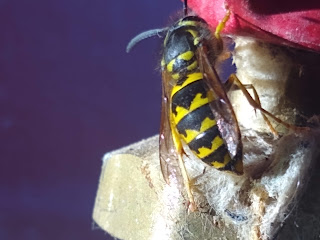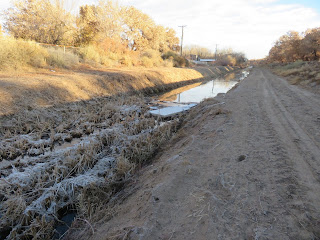The bosque is amazingly calm as another storm moves in from the north. Most of the time the moisture and cold do not manage to make it into the lowlands of Corrales. The Sandia range to our east rises five thousand feet above Corrales. Adapting to the weather is one of humankind's greatest achievements (shelter, clothes, communal food storage). Changing the weather itself may turn out to be one of our biggest mistakes.
I have noticed the songbirds are very vocal in the mornings. They are also flocking together into the areas they prefer. Each passerine species has a 5 acre space they seem to prefer as the sun rises. Interestingly it is not usually a bird feeder, which are stressful to the more reclusive species. Although it is sometimes a bird bath.
The larger passerines (robins, flickers, doves) seem more territorial and less found in flocks. They are engaged in competitive behaviors; territorial displays and courtship displays. They are definitely feeding too, but it is clearly not their highest priority.
The sandhill cranes feed in the morning and evening, during the day they are in small flocks and sometimes are posturing and being noisy. Most of these big birds appear to have paired off and are usually flying close to their partners. They are more solitary in Corrales than down in the Bosque del Apache preserve. This one is feeding in Heidi's raspberry patch, they low plants are ideal for their foraging style. In the early morning and evening they usually congregate with canada geese and settle near the river, depending on coyote activity.
This great blue heron is always fishing when the water is quietest, basically the early morning and late evenings. They look nothing like cranes, and act totally different as well. They usually have their necks tucked into the body when not out in the water
This red tailed hawk is reliably at a perch on the edge of the Heidi's field, I'm not sure what she might be hunting for, but she was watching a small flock of sandhill cranes, who did not seem to be very worried. The edges of a large field is their prime hunting ground for any small mammal.
Kestrels are not usually found in the bosque at other times of the year, but I think they come in to plan nesting sites in tree cavities. They are small mammal specialists, and track mice and chipmunks via their urine trails.
The start of bird nesting is officially considered to be March. This is likely an old nest from last year, but it doesn't not appear to have been used. However, the increase in bird singing I heard today is
a pretty certain sign that some birds are beginning courtship, mating and hence, egg laying and nest building. The high winds over the next few days is likely to dislodge some early nest building efforts from the high trees.
The bosque meets most of what some birds need for a good nesting site, and most surveys agree there is a high number of birds in Corrales. However, some birds like dense cover to feed, and others prefer an open field. This can create many headaches when trying to decide how to manage a bosque for different birds to thrive in. Russian olives grow densely, this helps some animals thrive but excludes others. Russian Olives are considered an invasive species by the forestry department, but many smaller birds have adapted to them in the environment. They have beautiful dense wood, but often produce dense thickets of thorns that burns fiercely.

The Corrales interior drain was dug to drain the marshy area for irrigated farmland and housing. There are many complex USGS documents that basically say this. The groundwater level is returning, most likely percolating back into the land beneath our feet from the river flow. I still wonder what made it drain so fast last year, and if it will ever return to former levels. Now, of course, we need a high groundwater level to restore former wetlands for the benefit of our natural environment. They are essential for cottonwoods to thrive.

It is odd that the more information there is on a subject, the more confusing the data is. Most sites talking about these box elder bugs are from pest control companies selling a service. They often overwinter in houses. I can save you some money;
all the sites say wait until spring, when all the bugs leave by themselves. These insects have a crazy amount of natural defenses against all predators, humans, insect, infections. Nature's colorful cockroach, and I mean that in a complimentary way.

This molt is possibly from some sot of bark beetle, but it could also be a moth species. Some insect high in the trees is beginning to molt into the adult phase and attracting the attention of flickers. Other than under the ground, the ecosystem in the riparian canopy is ridiculously understudied. This is well known in a biologist's advice on finding porcupines. "Keep looking up into the trees until you fall backwards, then you are looking high enough". The cottonwood riparian canopy in Western states is about 100 feet. In the East, with more regular water, the height can be twice that. Other than kids in tree houses, and the occasional deer bow-hunter, people do not spend any time living in trees.

When farmers moved towards the western US, they encountered far more erratic weather than they had seen in the East. Flood control and irrigation to tame the rain and rivers requires a lot more co-operation than most history books will admit too. Learning about water law will put anyone to sleep, but basically "muddling along" sums up the system pretty well. Most reliable water supplies are stored underground. The regulation of communal supplies is pretty sparse everywhere. However, the situation is less crazy in
New Mexico than in Arizona.
There is a regular small group of "song-dogs" that visit the clear ditch each morning. They leave behind scat and sometime leave late enough that they are seen running away. They are not apex predators so are always on alert for danger. Their scat is 100% fruit (apples and grapes) as they are omnivores and hunting is pretty poor. Sometimes the scat is made up of beetle wings or sunflower seeds from bird feeding tables. They seem to also relish horse poop.
They are hunted by mountain lion, though not in any appreciable numbers. Interestingly, they are killed more in areas "backyard farmers" than large farms. It is odd that people who "love nature" often are those that hate coyotes the most. Urban coyotes are going to keep thriving, but bobcats are a more likely culprit for those missing personal pets, as those are obligate carnivores.
Nature is always finding ways to overcome difficulty. This picture shows dandelions growing through ice on the bottom of the ditches. While they are well know for their presense in grass lawns, they grow everwhere. Dandelions, coyotes, and bow elder bugs are adapting to life with humans. Maybe one day humans will learn how to live with them, too.

























































